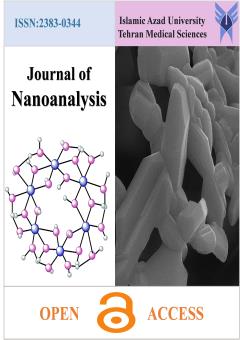Green synthesis and antibacterial application of silver nanoparticles using Oak Peel extract
Subject Areas : Journal of Nanoanalysis
Nooshin Japalaghi
1
,
Nahid Ghasemi
2
*
![]() ,
Majid Ramezani
3
,
Behrooz Shojaei saadi
4
,
Majid Ramezani
3
,
Behrooz Shojaei saadi
4
1 - Department of Chemistry, Arak Branch, Islamic Azad University, Arak, Iran
2 - Department of Chemistry, Arak Branch, Islamic Azad University, Arak, Iran
3 - Department of Chemistry, Arak Branch, Islamic Azad University, Arak, Iran
4 - Department of Chemistry, Arak Branch, Islamic Azad University, Arak, Iran
Keywords: silver nanoparticles, Oak, Green synthesis, Antibacterial activity,
Abstract :
The use of various plant materials for the synthesis of nanoparticles is considered as green synthesis, which does not involve any harmful chemicals. In this study, silver nanoparticles were synthesized by a fast, one-step method and a green biosynthesis method by regenerating a silver nitrate solution using Oak peel extract containing biomolecule which as a reducing and stabilizing element Suitable to play a role. Effective parameters such as pH of solution, silver nitrate concentration, temperature and contact time were studied and optimized The structure and properties of nanoparticles were determined by spectroscopic absorption analyzes UV-Visible, Scanning electron microscopy, X-ray diffraction and Fourier transform infrared spectroscopy. According to the Sherer-Debye equation, the size of the nanoparticles was measured 29 nm. Then the antibacterial effect of nanoparticles produced against two strains of pathogenic bacteria, gram positive Staphylococcuas aureus and gram negative Escherichia coli was investigated by disk diffusion and determination of minimum inhibitory concentration(MIC) methods. The results of the antibacterial activities test showed that the nanoparticles produced from Oak Peel had a good effect on both bacteria. The purpose of this research is to synthesis and develop a new method for the preparation of silver nanoparticles using environmental methods.
[1] A. Panacek, L. Kvitek, R. Prucek, M. Kolar, R. Vecerova, N. Pizurova. J. Phys. Chem. Biopset., 110,162 (2006).
[2] K. Govindaraju, S. Tamilselvan, V. Kiruthiga, G. Singaravelu. J. Biopest., 394,399 (2010).
[3] A. Nanda, M. Saravanam, Hil MP. Nanomed., 452,456 (2009).
[4] E. Zolfonoun, Anal. Method Environ. Chem. J., 1,5 (2018).
[5] A. Vahid, M. Abdous, S. Nayyeri, Anal. Method Environ. Chem. J., 1, 29 (2018).
[6] A. Ghozatloo, A. Zarei, M. Arjomand, Anal. Method Environ. Chem. J., 2, 63 (2019).
[7] B. Fahimirad, A. Asghari, Anal. Method Environ. Chem. J., 1, 47 (2018).
[8] M. Gajbhiye, J. Kesharwani, A. Ingle, A. Gade, M. Rai. Nanomed., 382,386 (2009).
[9] A.R. Shahverdi, S. Minaeian, H.R. Shahverdi, H. Jamalifar, A.A. Nohi. Proc. Biochem., 919,923 (2007).
[10] S.S Shankar, A. Rai, A. Ahmad, M. Sastry. J. Coll Interface Sci., 496,502 (2002).
[11] T. Mohasseli, Sh. Pourseyyedi. Biotechnol. Tarbiat Modares Uni., 10,20 (2015).
[12] Z. Zhanjiang, L. Jinpei. Rare Metal Mate Eng., 1700,1705 (2012).
[13] C. Jianrong, M. Yuqing, H. Nongyue, W. Xiaohua, L. Sijiao. Biotech. Adv., 505,518 (2004).
[14] S. Kaviya, J. Santhanalakshmi, B. Viswanathan, J. Muthumary, K. Srinivasan. Spectrochim. Acta Mol. Biomol. Spe., 594,598 (2011).
[15] K. Chaloupka, Y. Malam, A.M. Seifalian. Trends Biotechnol., 580,588 (2010).
[16] KH. Cho, J.E. Park, T. Osaka, S. Park.. Electrochim. Acta., 956,960 (2005).
[17] Y.Cao, R.C. Jin, C.A. Mirkin. Science 1536,1540 (2002).
[18] P. Christian, F. Vonderkammer, M. Baalousha, T. Hofmann. Ecotoxicology 326,343 (2008).
[19] C. Marambiojones, E.M.V. J. Nanoparticle Res., 1531,15551 (2010).
[20] J.L. Gardeatorresdey, J.G. Parsons, K. Dokken, J. Peraltavidea, H.E. Troiani, P. Santiago, Langmuir, 1357,1361 (2003).
[21] A.G. Dwivedi, K. Coll Suf. Phys. Eng. Asp., 27-33 (2010).
[22] S.S.K Kamal, H.R.S. Prasanta, V. Johnson, P. Manda, R. Shankar, D. Loganathan. Acta Chim. Slov., 808,812 (2010).
[23] P. Ghorbani, D Hamidialamdari, F. Namvar, P. Yaghmaei. J. Ilam. Uni. Med. Sci., 181,189 (2016).
[24] Iravani S, Zolfaghari B. Biomed. Res. Int., 1,5 (2013).
[25] G. Vonwhite, P. Kerscher, R.D. Brown, J. Morella, W. Mcallister, D. Dean. J. Nanomate., 1,12 (2012).
[26] M. Chahardooli, E. Khodadadi. J. Ilam Uni. Med. Sci., 27,33 (2014).
[27] R. Jabbari, N. Ghasemi, M. Ramezani, Journal of nanoanalysis, (in pres) (2019).
[28] G. Bhor, S. Maskare, S.Hinge, L. Singh, A.Nalwade, Asian J. Pharma. Tech., 2 (2014).
[29] N. Mirzaei, A. Mirzaei. Int J Biol, Pharm. Allied. Sci., 620,629 (2013).
[30] D. Andreescu, C.Eastman, K.Balantrapu, D. V. Goia, J. Mater. Res., 22 ,2488 (2007).
[31] M. Chahardooli, E. Khodadadi, E. Khodadadi, International Journal of Biosciences, 3 ,97 (2014).
[32] N. I. Hulkoti, T.C. Taranath, .Colloids Surf. B., 121, 474 (2014).
[33] J. I. Garadea-Torresdey, E. Goner., J.G. Parsons, M. Jose, Langmuire, 1357,1361 (2003).
[34]. Mastromarino, Paola; Vitali, Beatrice; Mosca, Luciana. New Microbiol., 229,238 (2013).
[35] S. P. Dubey, M. Lahtinen, M. Sillanpa, Process. Biochem, 45 , 1065 (2010).
[36] A.R. Vilchis-Nestor, V. Sánchez-Mendieta, M.A. Camacho-Lopez, R.M. Gómez-Espinosa, Z.R. Camacho-López, J.A.Arenas, Mater. Lett.62, 3103 (2008).
[37] A. Curatola, M. Moscatelli, D. Norris, A. & Hendricks-Munoz, K. Exp. Eye Res., 147,158 (2005).
[38] A. Muhammad, A. Farooq, R. Muhammad, S. Ashraf Janjua, I. Awais. Int. J. Mol. Sci., 9923,9941 (2012).
[39] A. Safary, H. Motamedi, S. Maleki, S.M. Seyyednejad. Int. J. Bot., 176,180 (2009).
[40] K. Seddik, A. Smain, L. Arrar, B. Abderahmane. World Appl Sci. J., 1144,1149 (2013).
[41] N. Sakai, K. Inada, M. Okamoto, A. Portuloside, Phytochem., 1625,1628 (1996).
[42] A. Bankar, B. Joshi, A.R. Kumar, S. Zinjarde, Colloids Surf. A., 58,63 (2010). [43] K. Mohan Kumar, B.K. Mandal, M. Sinha, V. Krishnakumar, Spectrochim. Acta. A, 490,494 (2012). [44] M. Sathishkumar, K. Sneha, S.W. Won, C.W. Cho, S. Kim, Y.S. Yun, Colloids Surf. B: Biointerf., 332-338 (2009). [45] E.K. Elumalai,T.N.V.K.V.Prasad, V. Kambala, P.C. Nagajyothi, E. David, Archives of Applied Science Research., 2 (6), 76 (2010).

